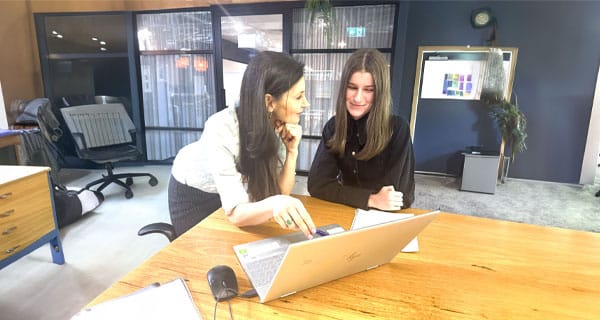
Credit: Sharon Givoni
Introduction
In the kaleidoscopic world of design, surface designers craft with colours and shapes, transforming plain surfaces into realms of imagination across fashion, home décor, and beyond. Yet, without the anchor of a robust contract, this creative journey can swiftly veer into stormy seas fraught with misunderstandings and unforeseen challenges. As a lawyer deeply embedded in the intricacies of copyright and commercial law, I’ve witnessed the crucial difference a solid contract can make. Here’s how to safeguard your artistic voyage.
Case studies – how legal contracts can help avoid problems
Consider Mia, a vibrant surface designer, who embarks on a project for a children’s clothing line. With dreams of seeing her patterns on adorable outfits, she bypasses the formalities of a contract, trusting in a handshake deal.
Months later, the clothing line introduces a new collection, but to Mia’s dismay, her designs are nowhere to be seen, repurposed without acknowledgment or compensation.
Then there’s Alex, a digital surface designer, who agrees to a contract hastily scribbled on a napkin in an enthusiastic meeting with a startup. When that startup is acquired by a larger corporation, his surface designs are used globally, far beyond the scope he’d imagined, leaving him without due credit or additional compensation.
These examples show just how easy it is to get swept away in the excitement of a job, but without a
proper contract, things can go pear shaped later.
Unfair Contracts Law in Australia: A Shield for Designers
In light of these scenarios, it’s pivotal to also understand the Unfair Contract Terms law in Australia, which offers a protective net against disproportionate and unjust terms that could disadvantage designers.
Under this law, terms that cause a significant imbalance in the parties’ rights and obligations or are not reasonably necessary to protect the legitimate interests of the party advantaged by the term can be deemed unfair and, therefore, void.
This is particularly relevant for surface designers working with larger entities. If you know that these unfair contract laws exist in the first place, this can help ensure your rights are safeguarded.
The Essentials of a Strong Contract
There are so many factors to consider when creating contracts or terms and conditions. Here are several key elements ,which, I need to stress, are not exhaustive:
- Identification of Parties: Clarify who is entering the agreement.
- Scope of Work: Detail the project’s scope, deliverables, and milestones.
- Payment Terms: Define compensation, payment schedules, and any royalties.
- Copyright and Licensing: Outline the rights transfer or licensing terms clearly.
- Revision and Approval Processes: Agree on how changes and approvals are handled.
- Termination and Cancellation Policies: Specify the grounds for and consequences of termination.
- Dispute Resolution: Set forth mechanisms for addressing disagreements, emphasizing mediation or arbitration for a less adversarial approach.
- Ensuring a Binding Agreement: With the digital era’s myriad signing options, from e signatures to traditional methods, ensure the chosen method reflects a mutual intent to be legally bound.
- Professional Drafting: Your Legal Compass
Confidentiality also comes up especially in the initial stages of negotiation or when sharing your portfolio.
Exclusivity clauses often come up and can be critical if you’re working with clients who demand exclusivity in your designs or want to prevent you from working with direct competitors for a certain period. Clearly defining the terms of exclusivity and any limitations on your ability to work within the same industry will be important so that you don’t hinder your own growth opportunities.
If the contract involves transferring IP rights to the client, ensure this is explicitly stated, including the conditions of the transfer and any rights you retain. In our firm we find the surface designers quite often want to licence their design for specific uses but retain copyright ownership so that they can repurpose or resell the design to others for different uses.
For designs that will be reproduced and sold, surface designers will often want to get income beyond the initial project fee. This seems to be particularly applicable to mass-produced items. The contract should detail how royalties are calculated, reporting requirements, and payment schedules. Diving deep into the specifics of these arrangements is not just a matter of thoroughness—it’s a proactive measure to forestall potential disputes.
We also like to check that the contract clearly outlines the process for delivering final designs, including formats, deadlines, and any acceptance testing or review periods. The last thing you want is a dispute about when a project can be deemed complete and how revisions are handled.
The ultimate safeguard for surface designers is engaging a legal professional specializing in copyright and intellectual property law. Tailored contracts, drafted with professional insight, not only protect your work but also steer clear of potential disputes and misunderstandings, providing a clear guide on usage rights and responsibilities.
Conclusion
In navigating the vibrant domain of surface design, the tales of Mia and Alex serve as stark reminders of the perils that lurk in the absence of clearly defined contracts.
Yet, these stories also illuminate the path to security and success, one of which is having a strong legal contract or your own terms and conditions in place and not signing anything without legal advice first.
As you embark on your artistic journey, let the drafting of professionally tailored agreements be your first port of call, ensuring that your voyage through the design industry is marked by triumphs, not tribulations.
Sharon Givoni stands at the forefront of copyright and intellectual property law for surface designers across Australia. With a wealth of experience that spans the breadth of the design industry, she has encountered nearly every conceivable scenario and navigated her clients through the complexities of legal protections for their creations. She is also known for her approachability and user-friendly advice.
Please note the above article is general in nature and does not constitute legal advice.
Please email us info@iplegal.com.au if you need legal advice about your brand or another legal matter in this area generally.


